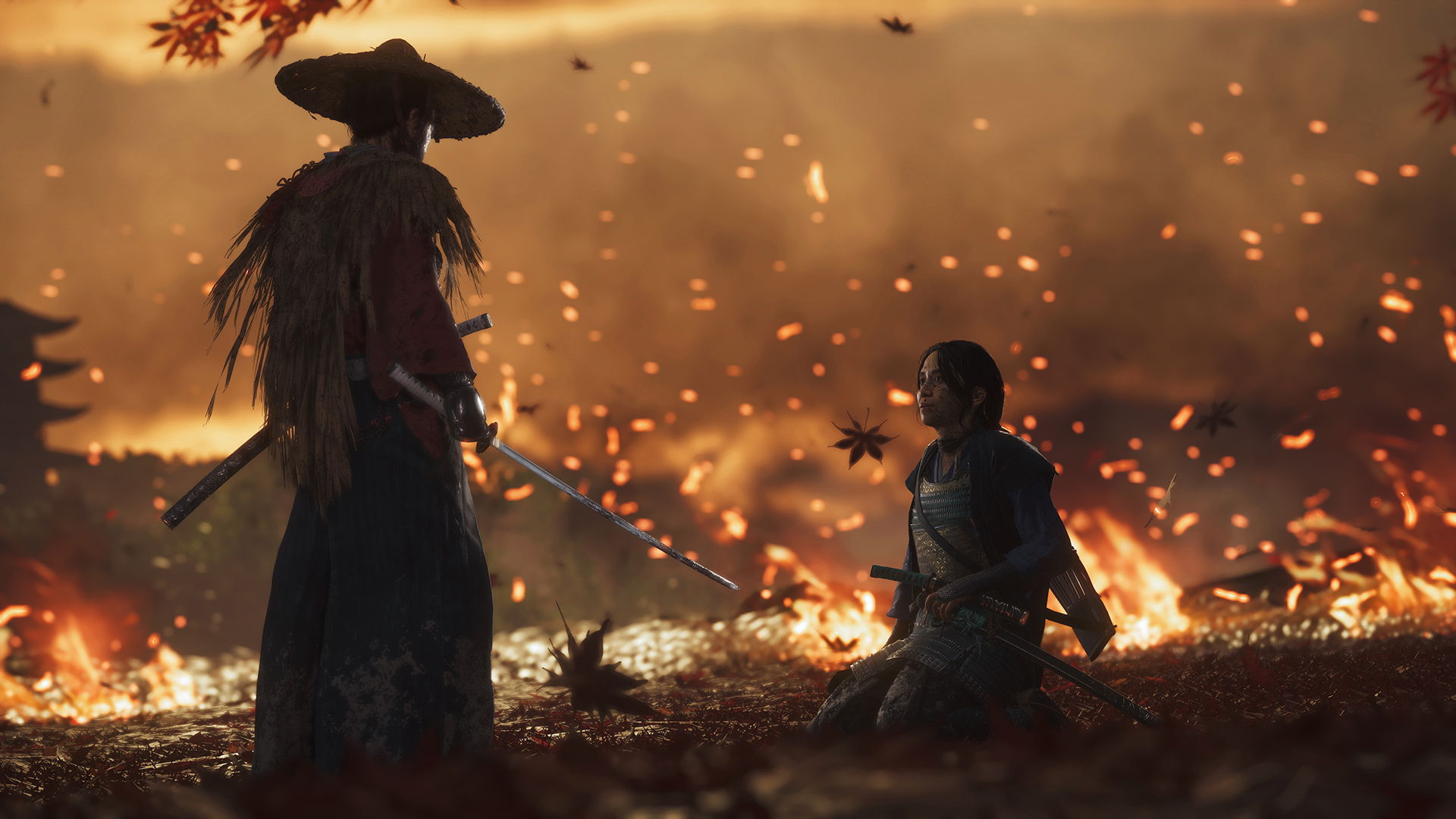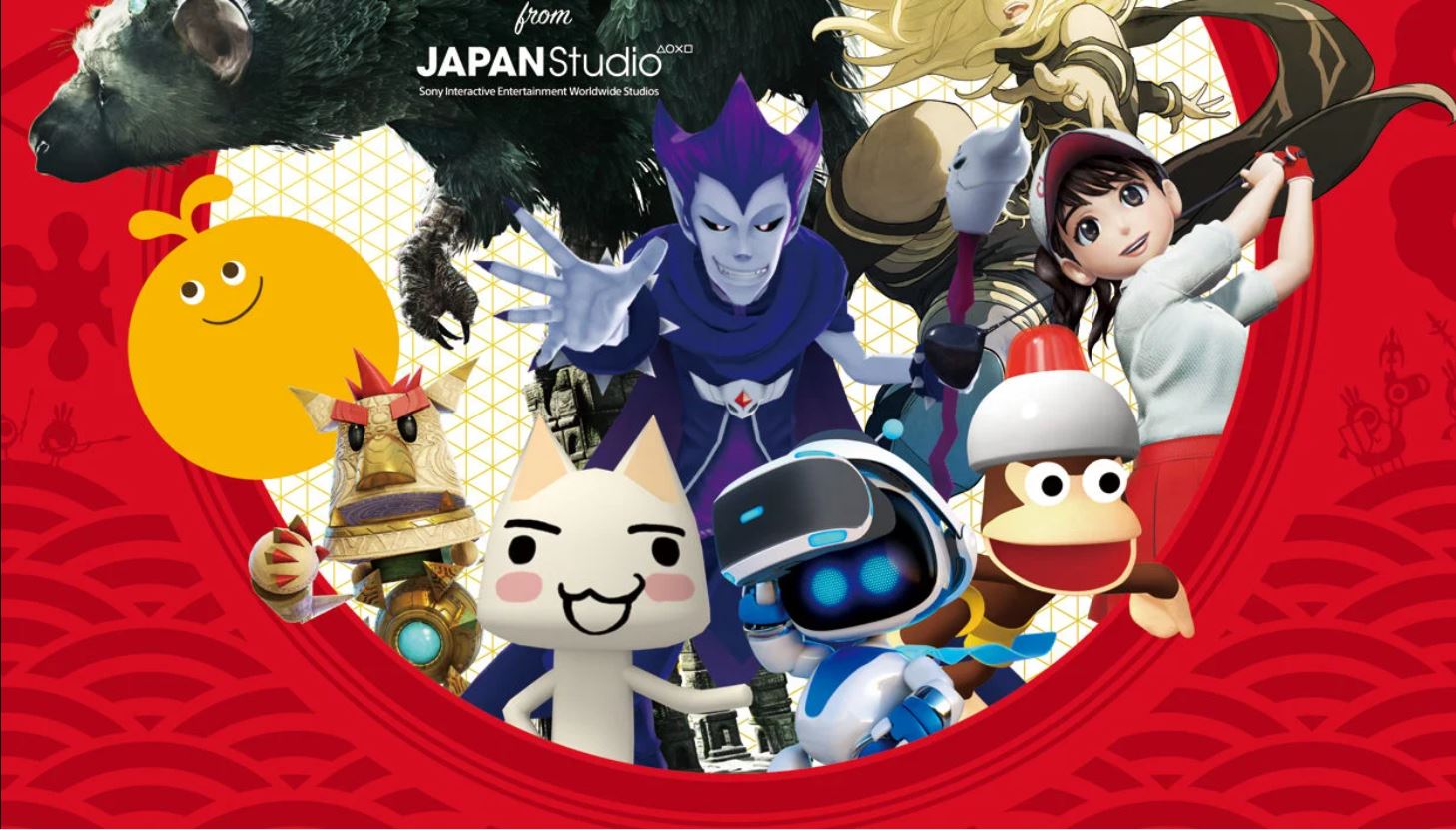Ghost of Tsushima Review – All The Colours of the Wind
If you know the enemy and know yourself, you need not fear the results of a hundred battles – Sun Tzu
Someone up there in the heavens of video game design has been listening to my prayers. Ever since Assassin’s Creed began establishing that it could be set anywhere in the world at any time, I have been wishing for one thing. We’ve been given Greece, Rome, Civil War America, London, Egypt, and soon even Anglo Saxon England, but throughout the last ten years, a clamour has been heard and wilfully ignored. Where did you always want Assassin’s Creed to go, and you never got your wish? Feudal Japan.
But to say it’s an Assassin’s Creed game is doing Ghost of Tsushima a disservice. Yes, it is an open world game with a bit of every other open world game that has come before, but it’s not a simple copy of any of them. It is more like a distillation of everything that makes them great. It is not just the stealth of Tenchu, or the katana combat of Onimusha, it is both of them and far more besides. Ghost is more than just the sum of its influences. At some point you transcend them, and become something new and incredible.
There has never been a samurai or ninja game quite like Ghost of Tsushima. It combines the historically accurate with the stylisation of Akira Kurosawa, breath-taking natural beauty with bloody visceral combat, a vast open world with incredible attention to detail. Its heavy in narrative, but also incredibly designed, working to hide mechanics and gimmicks in the natural space of the game, to draw you in and not let go. Let me explain, young Samurai.

The way of the Samurai is found in death – Yamemoto Tsunetomo
Tsushima Island is a real place and the Mongol invasion in 1274 really happened. Nestled precariously in open sea, on its own in the gulf between Japan and Korea, it is the site of the first Mongol Invasion of Japan (I say first, because they did it again a decade later). Some 600 ships set sail out of Korea, and arrived on Komoda beach. They attacked and took Tsushima, killing its hundred or so samurai defenders and then occupying the island, taking the peasants and the elderly as prisoners and slaves. That’s the history out of the way.
You play as Jin Sakai, a samurai who fights and falls at Komoda beach. Only destiny has other plans. Jin survives and is nursed back to health over the next few days, awakening to a very different island, one occupied and roamed by ruthless Mongolian warriors. So begins Ghost of Tsushima, a single-handed katana-wielding guerrilla resistance war against the invaders of your island. As a one-man army, Jin cannot simply challenge every Mongol to an honourable samurai duel – he would be overwhelmed in moments. Instead he is forced to bend the traditions of his class to save his people. Watching his descent from honourable samurai to the ghost that strikes from the shadows is a satisfying early part of the story, made convincing by a number of quests that force the honourable ways from Jin, in favour of practicality. The teachings of a female thief named Yuna are particularly useful to this new found course, where the more stoic of the island’s survivors, such as the elderly Sensei Ishikawa, find the changes to Jin’s style troubling and dishonourable.
Over the course of the game, the legend of the Ghost grows through fear and word of mouth, inspiring an island to fight back. When these rumours begin to be heard openly as you pass NPCs, your legend really starts to feel real. I don’t think I’ve seen someone become a legend in a game this realistic, in quite this way before. The rumours, and Jin’s systematic cleansing of the Island, cause no end of trouble for the fantastic frustrated villain of the piece, the huge overgrown general of the Mongols, Khotun Khan, cousin of the famous Kublai. He is a grand villain, and in the first ten hours of the game, I only wanted to see more of him.
It’s a satisfying, if simple, story of struggle and rule-breaking to survive and triumph over adversity, and it carries the game well, because of its simplicity. In a genre where myriad quests can coax you away from the main narrative thread, having something so clear cut was helpful. The story does not have the flair or drama of the Kurosawa epics it has been influenced by; it has been too westernised for that. It lacks much in the way of intrigue or politics, and for all its westernisation, samurai by virtue of their teachings innately lack the emotional drama that some of this plot demands. Jin feels, but he packs his emotions away for the most part, making it hard to really feel the drama in places.

Think lightly of yourself and deeply of the world – Miyamoto Musashi
There is no getting around it; Ghost of Tsushima is a beautiful game, and the island is a joy to explore. The only comparable worlds I can think of are those of Horizon Zero Dawn, and Crysis. Views out across the island are simply breathtaking and the draw distance goes on forever. From dawn sun-dappled rolling hills to sunset orange blazing over barren peaks; from violet chrysanthemum-covered hillsides to cultivated Japanese gardens and raked gravel shrines; from the wonder of the golden forest with it’s falling yellow leaves and five-tiered pagoda to the smoky ruins you can see on the horizon, only to visit that same burnt town later on, the locales that Sucker Punch have created are amongst the most beautiful ever programmed, on any system, ever.
It is truly mesmerising to walk through the golden forest and find the golden temple pagoda at its centre. I caught my breath and just stared at it for a long while, letting the swirling leaves rush and fall all around, so long in fact I thought one of the monks might come and see if I was okay. It’s trite these days to say the world of the game was a character in itself, but for Ghost of Tsushima, I doubt anyone who plays in it will ever forget Tsushima Island.
You can sometimes get a little overcome by the beauty of it all. But that’s when the Mongols are most likely to make their presence known. You’re galloping over a lush hillside of bluebells as far as the next valley, and your alert pings. A small group of marauders have taken a woman hostage and are beating her. The bluebells become the site of a drumbeat-backed bloodbath in seconds as you dispense justice. Nowhere is sacred and nowhere is safe from the slaughter that has overcome this picturesque island.

Tsushima Island is a long thin map, split into three disparate sections, which you will visit and liberate as you proceed through the game. When you discover your map, the coolest thing is that it has regions, that must be liberated from Mongol control. This has always been my favourite way to play open-world games. Take back the map, one section at a time. AC: Syndicate, GTA 4, Spider-Man, some of the best open world titles have made great use of this mechanic, and it really plays into the gamer’s mind; that systematic need to discover, to clear and reclaim the island.
As in any open-world game, Tsushima Island is littered with hundreds of things to do. Narrative quests advance the story, but there are dozens of others, liberating camps and towns, helping interesting survivors take back their homes or simply taking in the beauty. Early quests involve helping an aggrieved noblewoman get revenge for the massacre of her clan, not at the hands of Mongols, but traitors; or your Sensei, who, singularly unconcerned by Mongols, is hunting a dangerous ex-pupil across the island. Along with quests for legendary armour and weapons, or literally hundreds of shrines, foxes, singing crickets, and Mongol artifacts to find, there is never a dull moment in Ghost of Tsushima.
Each quest feels more like a vignette about life under Mongol occupation, than a typical game quest. There are also very few fetch quests; instead most are actually go here, save this person, track this person, or slay these Mongols, rather than find this item. It was notably rare to have a fetch quest, which, in a game of this type and size, is an achievement on the part of the scenario designers.
Everything you do and everywhere you go on Tsushima is guided by the divine wind. The developers have been at pains to have no HUD and nothing encroaching on the beauty of the game world, and so have designed this wind mechanic to take you where you need to go. Mark a spot on your map, or the next quest, and the wind will change direction and literally blow you towards your destiny, sorry, destination. You can see it in the bowed grasses and plants, or the leaves dancing in the air. This makes for a wonderful feeling at the start of each quest, as if to say the winds of change or destiny are with you. It makes the game feel almost magical. This constant wind mechanic also means that nothing is ever still; the island of Tsushima is truly alive.
You will also collect the materials for fashioning lots of customisable armour, sword scabbards, hats, bows, and kimono. If I could level a criticism, its that just like another high-profile first party release last month, there is too much damn looting needed, meaning I end up delving into every house, walking the tatami-mats systemically looking for bundles of supplies when I could be enjoying the locations more.

Victory is reserved for those who are willing to pay its price – Sun Tzu
If you are one for sound design and music, Ghost is a masterclass in auditory wonder. The authentic instrumentation and compositions are fantastic. Peaceful lullabies, lilting strings, swelling, pulsing battle themes, and echoing blasts. It’s a stirring masterpiece of composing. Mongol settlements and logging camps are themed with throat-warbling Mongol singing, Japanese pagodas and temples are themed with zithers and twanging strings.
It’s quite possibly the most atmospheric game I’ve ever played. Music is essential to this but Ghost is a stylish cinematic creation in so many areas not normally given that much weight in games. Lighting is something to behold, the sunsets and sunrises and blazing skies flooding your eyes on a regular basis just blew my mind. Camera work is striking, from tilted cams when galloping, to actually using different depth of field lens effects during the showdowns. The constant wind, ambient nature noises and rolling mists combine to make your average journey from A to B more cinematic than Kojima’s finest work.
They have even gone so far as to incorporate what’s called Kurosawa mode; a black and white, heavy grained, high contrast mode that makes everything look like an old samurai movie. This mode’s best results come in the showdowns and duels when cuts and camera angles can do their work, rather than the normal over-the-shoulder angle. Ghost also features one of the most extensive photo modes I think has ever been incorporated into a video game, and if you are of an artistic nature there is no end to the wonderous creations possible. Just stop anywhere and make something beautiful.

Engage in combat fully determined to die and you will be alive; wish to survive in the battle and you will surely meet death – Uesugi Kenshin
It wouldn’t be a samurai epic without swords and combat. Ghost of Tsushima’s story is built around the desire to have a character steeped in both the honourable combat of the samurai, but also in the stealth combat of the ninja. Let’s take each separately because they each have enough nuance to carry an entire game on their own.
Jin is an accomplished swordsman, capable of instant kill slashes or flurries of blocking, rolling and dodging, and you will need to learn how to use him to his full potential. Combat gameplay is close in style to the Assassin’s Creed series’ latest offerings and relies on patience and deft timing. Button-mashing will get you nowhere. Instead the more stoic, emotionless swordsman, prepared to wait for the enemy to commit to his first move, will generally win out. Many enemies can simply rebuff your attacks, so you need to wait, watch for their tells, and parry, before getting your chance to strike. It’s simple, far simpler than the parrying in For Honour, for example, but it’s also satisfying.
Parrying and dodging will seem very difficult to start with, but you will learn quickly, young samurai. Hone your reflexes, watch carefully and before long you will become an unstoppable twisting, dodging whirlwind on the battlefield. Sucker Punch have incorporated a system of four stances into the swordplay, and though I was initially sceptical I’d use any of them, as I generally find I don’t need to in most games, here they are deftly balanced and quickly become natural. Stone stance is good against swordsmen, while water stance gives you moves that will overcome shields. After a few hours of experimentation, you will begin to see the benefit, and then with practice incorporate switching stances on the fly as you fight. They can also make a furious battle something quite beautiful to watch back, if you think you did particularly well.
Counterintuitively health is not an item, but is given to you via prowess in battle. When you need health, because you suck at the combat, you won’t get any. But parry and kill with skill and you will be rewarded with more health ups than you need. The game demands perfection from you.
Standoffs and showdowns complete the systems around samurai combat, allowing you to call out one or a group of Mongols for an honourable skirmish. Hold triangle, as if holding your blade in its scabbard, until the last possible moment. As your enemy commits to their attack, you release and one-shot slice them across the body. With learned skills, this can extend up to three people dispatched in beautiful slow motion, before the Mongols even know what hit them. Showdowns are the game’s bosses, who can be either samurai or Mongol in one-on-one deathmatches. Honour deprives you of your bow or your throwing weapons, and the system of parrying, waiting for openings and the feel of real samurai combat is never greater than in one of these duels.
With a swish across the touchpad dedicated entirely to flicking blood from your sword and sliding it back in the scabbard, you can make already visceral bloody bouts into almost choreographed duels. It’s quite a feat on the part of Sucker Punch to have translated the way of the samurai from a muscle memory swordplay art form into a button-pressing dance entirely using a controller, but somehow it feels natural and cinematic.

Stealth gameplay is fun, if a little simple, and this mode does little you haven’t seen before. You can crouch, creep, and crawl underneath houses or scale walls and roofs to get the drop on unsuspecting Mongols. Before long you have a grappling hook you can use to swing silently over the heads of your enemies. The first time you dive from above and plunge a katana in through the collarbone of an enemy will stick with you as its glorious. If all that combat wasn’t enough, Jin also embraces the tools of the ninja. You can wield throwing kunai (little weighted daggers), clay pots full of gunpowder, or coated in tar to stick to armour, or firecrackers and wind chimes to distract and confuse.
Combining these styles is the key to a successful battle. When you get overwhelmed, which can happen a lot with enemies that basically cannot be attacked without patience and openings, throw out a kunai or two to disable enemies and gain the other hand. I took to hurling sticky bombs out at the biggest bruisers in the Mongol army or the fur-armour wearing nightmares, just so that I didn’t have to fight them along with half a dozen of their mates.
The last of a packed combat roster is archery. Jin can use a couple of distinct and balanced bows, each more accurate than the last. With a trigger finger on L1 your can deflect arrows from the air, and give yourself one second to take aim and let fly with your own. Concentration allows yet another slow-motion trick giving you that extra time needed to put down Mongols running in from every direction.
Combining every tool at your disposal is a breathless flurry of activity and can initially make Ghost’s combat a tough ask. But like any skilled samurai, practice makes perfect. I can barely find fault with the combat systems here, and only the lack of a lock-on comes to mind. This frees you to enemy-hop like Batman in Arkham Asylum, but it can mean the camera swings in the wrong direction at the most inopportune moments. More than once I found myself trying to control the camera as well as myself in battle and that is very trying.

The dance of battle is always played to the same impatient rhythm. What begins in a surge of violent motion is always reduced to the perfectly still – Sun Tzu
If there’s a criticism to be leveled at Ghost it could be argued it’s not very new. Instead, it’s a distillation of an entire console generation of open-world game innovations, tested formula from AC, Far Cry and Horizon, wrapped up and delivered in an incredibly beautiful package to cap off the PS4 generation. But Ghost is more than just the sum of its influences. At some point you transcend them, and become something new and incredible. Ghost is a historical epic, and it basks in what came before.
I may have wished for an Assassin’s Creed in Feudal Japan, but what I got was something so much better. I can imagine an AC game here, full of mindless fetch quests, bad acting, overwritten dialogue and parkour, and I’m so glad that’s not what we got.
Ghost has everything it needs, well written quests, hidden locations, breath-taking graphics and a dozen massive collectathons, but it does them all with a flair and an eye to design that you rarely see. Here the open world genre has been made magical, natural and undeniable. Combat is satisfyingly cinematic, fully aware of its influences, it’s slow motion nods and systems based entirely in samurai cinema. I’ve not played another quite like it.
Perhaps the most telling feeling I can leave you with is this. The best games hook you in and don’t let go, and the best open-world games must do this over and over and over. Ghost of Tsushima has that one more quest, one more job gameplay that coaxes you back saying just one more quest, one more hour, until the morning sun is dappling through the bamboo forest, glinting off your katana and you realise the dawn has come.
Ghost of Tsushima is Sucker Punch’s masterpiece. With the depth of its combat, its incredible open-world design and its rich historical authenticity and cultural legacy, it’s a heady contender for the most incredible release of this console generation. It’s definitely the best samurai game ever made.
9/10
Ghost of Tsushima is available now only on Playstation 4.
Developer: Sucker Punch
Publisher: Sony
Disclaimer: In order to complete this review, a copy of the game was purchased. For our full review policy, please go here.
If you enjoyed this article or any more of our content, please consider our Patreon.
Make sure to follow Finger Guns on our social channels –Twitter, Facebook, Twitch, Spotify or Apple Podcasts – to keep up to date on our news, reviews and features.



